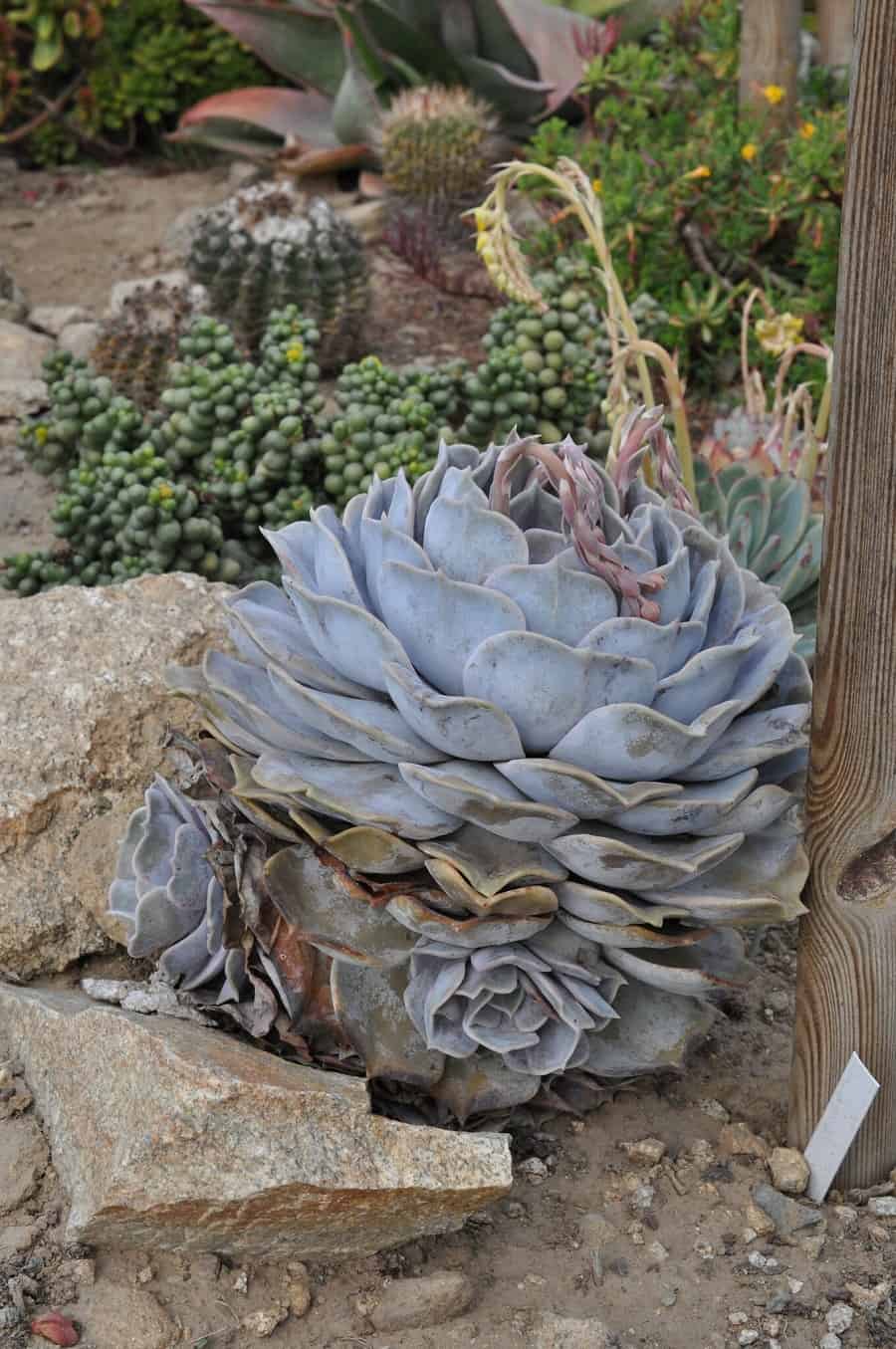The Echeveria lilacina ‘Ghost Echeveria’ is a species of succulents in the Crasuláceas family.
Its origin is Mexico, and its original habitat is to grow on rocky outcrops in the mountains.
This succulent is one of the most beautiful of the echeveria family but slow growth. It is drought-resistant and ideal for growing in rockeries, but also in planters, terrace, or pots.
The Echeverias are more than 150 species distinguished by their rosettes formed by leaves of generally bluish-green tones.
Its particularity is the fleshy leaves, rather ovate in shape and arranged in a rosette very compact.
The color varies from intense green, to pale blue, to bluish-gray, to pinkish green.
Echeveria Lilacina has some very particular flowers that are really attractive to the naked eye, especially since they are not common.
They are quite striking because they are supported by a taller than usual stem that is at least 15 cm long.
These fall like bells from the top of the small branch and have the ability to be seen from far away. They are quite different from all the others.
It blooms from spring to summer.
You may like: Trichocereus bridgesii
Echeveria lilacina ‘Ghost Echeveria’ Care:
Watering:
The Echeveria Ghost is very sensitive to excess water; it’s the only thing you should be more careful with.
Echeverias are not complicated succulents to grow, as long as you follow some basic rules.
Make sure not to let the water settle in the soil, as it can cause rot or fungal, which will kill the plant.
During the fall-winter period, the watering should be reduced considerably, and if the temperatures drop too low, it is best to stop the watering.
During summer water, every time the soil is dry—usually 2 times per week.
Illumination:
The Echeveria Lilacina grows with optimal conditions when it gets enough light.
But be careful not to expose the plant to direct sunlight since this could cause burns.
The illumination is essential for all plants, especially succulents, as it’s vital for leaf pigmentation.
Substratum:
They prefer poor soil, which ensures excellent drainage and aeration.
The specific substrates for cacti are the most suitable since they also contain high doses of magnesium, which comes from root rot.
Echeveria lilacina does well in both pots and rock gardens and is commonly used to fill gaps in this type of rockery.
Fertilizer:
The fertilizer should be added from the spring and throughout the summer, fertilize every 15 days.
You can supply a liquid fertilizer (specific for succulents) to dilute in the water, reducing the doses with respect to what is indicated in the fertilizer.
Do not fertilize in fall and winter, because the plant goes to vegetative rest.
To ensure optimal growth, supply nitrogen, phosphorus, and potassium balanced fertilizer 30 30 30.
Also, make sure that the fertilizer always contains microelements such as iron (Fe), manganese (Mn), copper (Cu), zinc (Zn), boron (B), molybdenum (Mo), magnesium (Mg), these are important for proper growth of the plant.
Temperature:
Ideally, in spring and summer, the temperature should not exceed 27⁰C/80°F. In winter, avoid temperature below 15⁰C/15°F; these low temperatures can kill your plant.
Technically it can resist sub-zero temperatures, but I suggest you protect the succulent indoors.
Pruning:
The echeveria lilacina does not need to be pruned; it will only require that you remove those parts that are in poor condition.
Transplant:
As the plant grows, you can transplant to a bigger pot during the hot seasons.
To repot this succulent, make sure the soil is dry before carefully removing it from its container.
Remove old soil from roots, making sure to remove any rotting or dead roots in the process.
Place the plant in a new pot and fill it with cactus and succulent soil. Let the plant dry for about a week, then start watering lightly to reduce the risk of root rot.
Propagation:
Echeveria lilacina produces small buds around the base of the plant.
Just pluck them carefully, allow the shoots to dry for a day or two before replanting them in well-drained soil.
Some experts recommend planting them in a completely dry substrate and adding water little by little to stimulate the growth of the roots.
Plagues and diseases:
They are very resistant to pests, but mealybugs, aphids (especially in flowers), and mollusks (snails and slugs) are enemies that must be monitored and controlled.

1 thought on “Echeveria lilacina ‘Ghost Echeveria’”
Comments are closed.